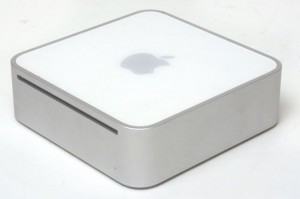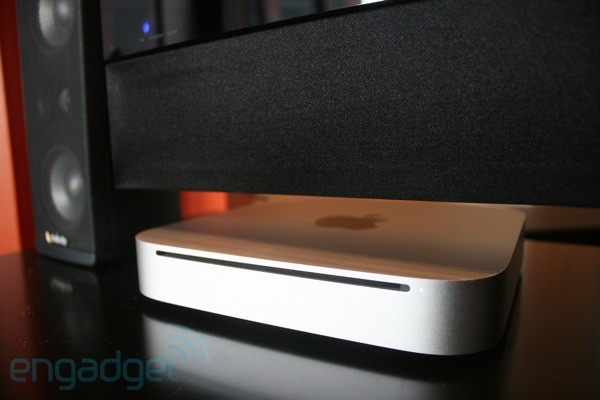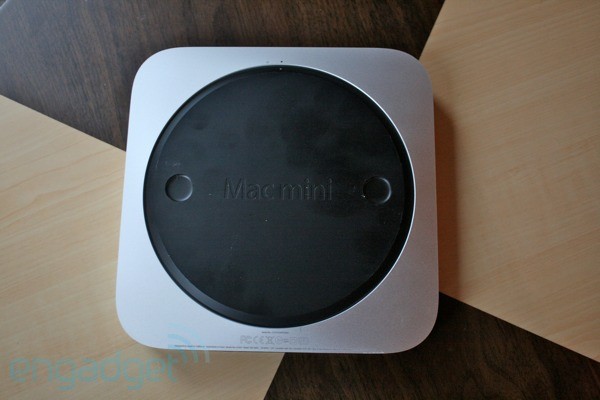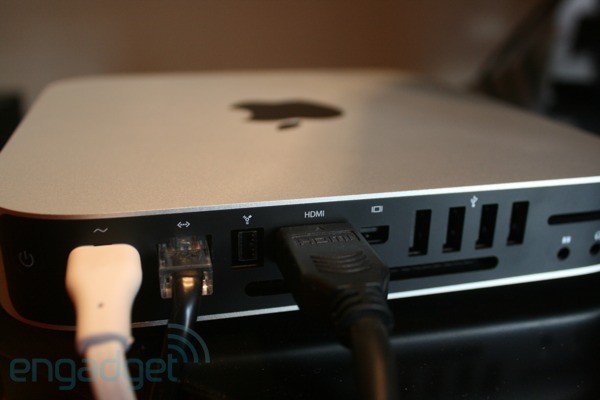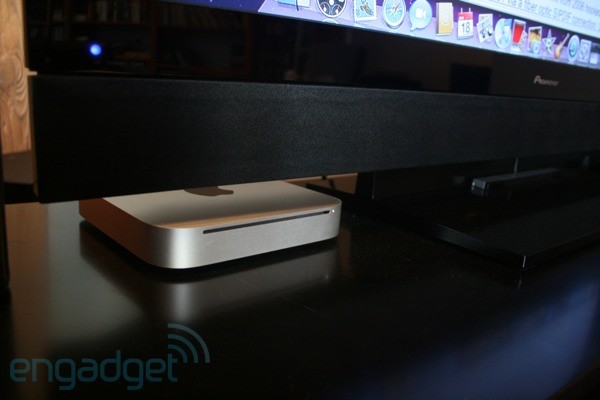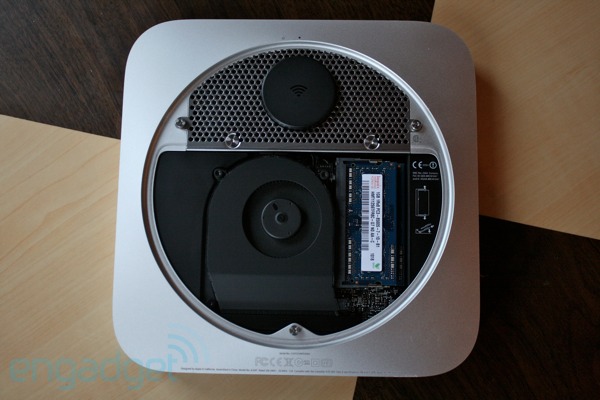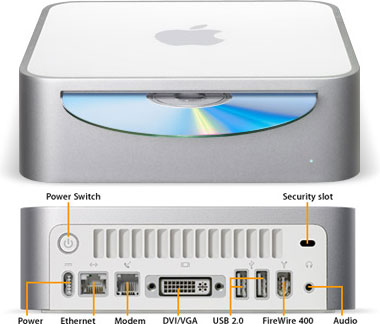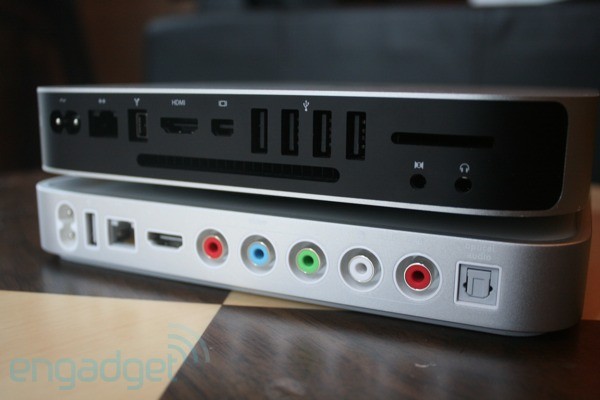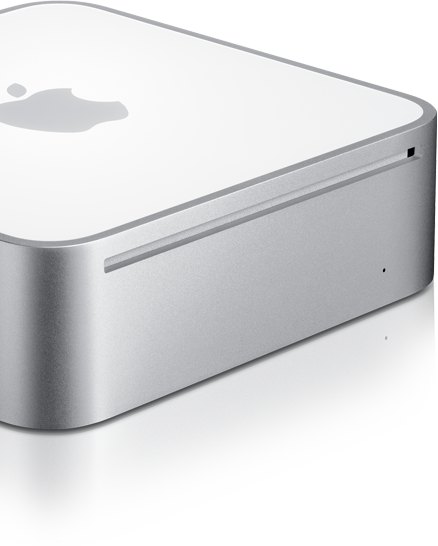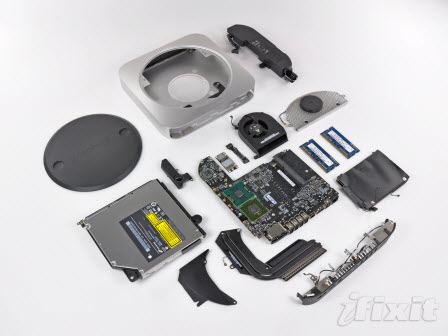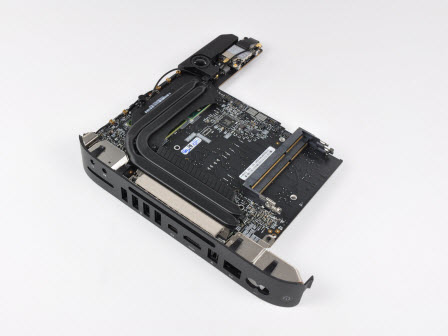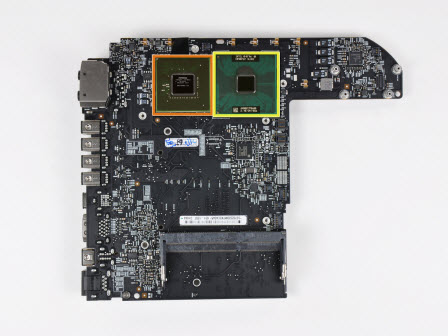M yourac mini 2010 is for your tv with latest technology.Enjoy Mac mini 2010….
Apple recently released a redesigned version of its entry-level desktop computer, the Mac mini. Macworld’s own Dan Frakes gave us his initial hands-on impressions as well as a photo tour of the $699 desktop computer. And though the biggest changes may be external, there are a few under-the-hood improvements that helped boost the system’s performance in our Speedmark 6 test suite.
The Mac mini has long been the oddball child of the Mac family: it’s the only consumer-level machine from Apple that isn’t a fully-integrated experience, and it’s the only Mac to have had a sub-$1,000 sticker price in some time. But people love this little weirdo, and they love to do weirdly awesome things with it — we’ve seen Mac minis stuffed into everything from old G4 Cube shells to volleyball-playing robots to pianos to… DeLoreans. Yes, DeLoreans. And, of course, people have longed been connecting Mac minis to HDTVs and using ’em as a media players — it’s small, quiet, relatively powerful, and it’s a real computer, so it can play virtually any video file you throw at it. And now it’s gotten even more attractive as a home theater PC, since Apple’s given the newest Mac mini a striking unibody makeover, NVIDIA GeForce 320M graphics, and — a first for any Mac — an HDMI port, making it a dead-simple addition to your HDTV.
The new mini represents the first major redesign in the product’s history since it was first introduced in 2005. That’s partially a testament to the minimalist good looks of the previous design, of course — it’s managed to blend in with every Apple design trend of the past five years. By the same token, the new design promises to have equal staying power: it’s at once both simpler and more deeply considered. Obviously the major portion of the case is the aluminum unibody, which is thinner than the previous-gen at an inch and a quarter, but slightly bigger around at seven by seven inches square. Apple tells us the new and old minis are essentially the same size by volume; you might think of the new mini as being a flattened-out version of the old. In fact, the new mini looks like nothing so much as the Apple TV.
Steve Jobs announced no such device and it didn’t get the silent rollout of just a press release in the days after the developer conference. But something else did. A re-designed Mac mini.
I don’t know about you, but I love my Mac mini and barely used my Apple TV. My Apple TV was mostly left off because I don’t like having to run all my content through iTunes to get to it, the interface was a kludge, the remote control was terrible and the thing ran hotter than hell. I refer to it in the past tense because it is no longer part of my home entertainment system.
The first thing you’ll notice about the new Mac mini is its box. Or, more specifically, how small that box is–60 percent of the size of the previous container. Open the box, and you’ll immediately see why: the new Mac mini, while wider than the previous model, is only 1.4 inches thick. And something else is missing–the power supply. Instead of the heavy, bulky, white power brick that’s shipped with every mini since the line was introduced, the newest mini comes with only a thin power cord and a video adapter. In the process of redesigning the Mac mini’s enclosure, Apple was able to shrink down the power supply and fit it inside the mini itself. (The new mini is actually slightly heavier than the previous model’s enclosure, but the lack of an external power supply allows the new version to shed about a pound of weight overall
The mini’s visual redesign takes its cues from two other Apple products. The new enclosure is made of a single piece of aluminum, a la Apple’s unibody laptops–gone is the plastic top of previous models, making the new mini feel rock-solid. But the shape is closer to that of the Apple TV–thinner and wider than the previous Mac mini models. In fact, the new mini is almost exactly the same size as an Apple TV, just with rounder corners.
My Mac mini — on the other hand — is an integral part of my home entertainment system. It runs the full Mac OS and all the software that I use all the time. It has a fair amount local storage that is easily expanded with inexpensive external drives and it plays every type of media that I own, not just the ones that Apple blesses to work with iTunes. Plus there are a plethora of peripheral options available for it including Bluetooth keyboards and mice, heck I can even VNC to it from my iPhone and do all kinds of neat remote control tricks with it. It even plays DVDs.
The new mini doesn’t actually sit flat on a surface — it actually rises up off the ground by a few millimeters on a circular pedestal. This is for two reasons: the front lip houses an air intake, which is vented out the back, and it also creatively conceals a WiFi antenna, which would otherwise be stifled by that all-aluminum enclosure. Bluetooth and a second matching WiFi antenna are also located on the plastic back panel for 360-degree coverage. We tried the mini all over the house on our 5GHz WiFi network and suffered zero problems, so it seems like this little trick was effective for us — we’ll see how others with larger or more complex WiFi setups fare.
About that pedestal: as you might have noticed from our hands-on photos, flipping the mini over reveals a circular access door, which you can twist off to get at the RAM. It’s hard not to marvel at the sheer Apple-ness of the panel the first time you interact with it — other companies simply don’t make computers like this. Unfortunately, you can’t get at anything other than the RAM once the panel is off, as the hard drive isn’t user replaceable. That’s pretty silly, in our opinion: hard drives have a nasty habit of failing, especially when you run ’em non-stop in servers and video playback machines, and we’d much rather have a hard time upgrading the RAM once at the outset than feel helpless about replacing a glitchy hard drive.
On the back of the new mini, you’ll find all the mini’s connections. As with the previous version, you get Gigabit Ethernet, FireWire 800, a Mini DisplayPort connector, digital/analog audio input and output, and four USB ports served by two USB buses. But you also gain–at the expense of a USB port, which is why the new model has four instead of the old model’s five–an SD-card slot. (Apple hasn’t yet published the specs and compatibility for the slot.) This card reader is less accessible on the back than it would have been on the front, but in a briefing with Macworld, Apple conceded that the compact design of the new Mac mini does limit where ports and connections can be placed.
Round back there’s a pretty standard array of ports: three USB, FireWire 800, gigabit Ethernet, an SDXC card slot, mini DisplayPort, HDMI, mic in, and audio out, which supports optical out as well. Apple says the idea is for the mini to be able to plug into most everything out of the box, so there’s an HDMI-to-DVI adapter packed in the box, and you can obviously score a VGA mini DisplayPort adapter as well. The HDMI port itself is said to be “HDMI 1.3-compliant,” and it’ll carry up to eight channels of audio and run displays up to 1920 x 1200, although it doesn’t support the little-used Deep Color. As with the previous mini, you can use both display outputs simultaneously; the mini DisplayPort supports a max res of 2560 x 1600. Oh, and this is the first time Apple’s done an SDXC slot, so that’s nice — expect to see that on other SD-equipped Macs as time goes on.
The new mini drops the previous model’s mini-DVI port in favor of an HDMI output–a nod to the fact that many Mac mini owners use the computer in home-theater systems and for other AV uses. In fact, Apple has even updated the Displays pane of System Preferences for the new mini to let you tweak video underscan–useful when connecting the mini to a TV. (Sorry, AV lovers–there’s no update to Front Row. Apple told us this Displays option is the only software change you’ll find
The mini is also exceptionally quiet: we never heard the fan kick in, even while we played games or watched videos. That’s not to say the fan wasn’t going, but just that we never heard it. Given our recent experiences with incredibly obnoxious MacBook Pro fans, we’re marking that in the plus column. The mini was also laudably cool — we never felt it get even slightly warm after a full day of testing.
Of course, there’s one very notable hardware omission here: a Blu-ray drive. It’s sort of amazing that Apple will happily sell you a $700 computer with an HDMI port that doesn’t support the best, easiest and highest-quality consumer HD playback format available, but for whatever reason the company just doesn’t offer any machines that do Blu-ray, even though it’s a member of the Blu-ray Disc Association. When we pressed them about it, Apple told us they just don’t see customer demand for BD drives because the format has yet to take off. We obviously disagree, but that’s the final answer — maybe the mini’s newfound affinity for HDTVs will finally push Apple to offer Blu-ray in the future.
Internally, you get Bluetooth 2.1 + EDR, but the new Mac mini also supports 802.11a/b/g/n wireless–Apple didn’t officially support 802.11a on the previous model. The new model may also provide better wireless performance thanks to the placement of its two antennas: one in the rear behind the plastic back panel, and the other on the bottom, near the front of the mini, also behind a plastic cover.
At this point the performance characteristics of a 2.4GHz Core 2 Duo Mac with a 1066MHz bus are pretty familiar territory; Apple’s had similar basic hardware in its lineup since 2008. The new mini adds the NVIDIA GeForce 320M graphics processor to the mix, which is a more potent successor to the familiar 9400m from the previous model — it’s still integrated graphics, but it’s reasonably fast integrated graphics.
In addition to one USB port, the new model is also missing one other connector: a security-lock slot. Apple’s infrared Remote remains an optional purchase.
The new Mac mini was more than capable of basic tasks like browsing, word processing, and running iTunes. And unlike the Atom- or Ion-based nettops you might consider putting under your TV, the mini is also more than capable of running HD Flash video without any hesitation — and it’ll be even better when Flash 10.1 “Gala” ships with hardware video acceleration for Mac OS X. The mini can also play virtually every other video file you might throw at it using either QuickTime with the open-source Perian component or other popular video apps like VLC or Movist, which is our new favorite. We didn’t have any issues playing 1080p files from a variety of sources, and we wouldn’t have any hesitation doing a little light iMovie work on the side. On the straight benchmark front, the mini put up a Geekbench score of 3385.
The actual upgrade process is among the easiest of any Mac. To open the mini, you just flip it over, place your thumbs in the two recessions you find in the black-plastic base, and turn that base counter-clockwise a few degrees. The base then lifts off, revealing the two RAM slots on the right-hand side. Release the clips for each chip, lift them out, put new ones in, and you’re done. You don’t even have to use a screwdriver, let alone a putty knife!
Where the mini does struggle is gaming performance. Although the GeForce 320M can handle less taxing games and lower resolutions just fine, it can’t hang once you crank things up — we averaged between 17-20fps running Portal at 1920 x 1200 with the default settings, and about the same when we ran it at 1080p connected to our TV. If you’re willing to step it down, though, you should be fine — we got 30fps running Half-Life 2 Episode 2 at 1280 x 800. Passable, but if you’re a hardcore gamer you’re probably not looking at Macs anyway.
While you’re inside, there are a few interesting things to see. One is the mini’s new 85-Watt power supply, which is just to the right of the RAM slots. It’s tiny. You can also see, right in the middle, the mini’s small cooling fan. It actually draws air in through a small gap around the base and then pushes that air out a small exhaust opening on the back panel.
The round, black item near the front of the mini is one of the two AirPort antennas. The section of the base that covers this antenna has no metal to allow for better performance.
People have been using the Mac mini as a basic HTPC for years now, and the new model’s HDMI port certainly makes it seem like Apple’s given the little guy its blessing to invade the living room. It’s not quite that simple, though — and if you were hoping to just drop in the new mini in place of an aging Apple TV, well, you’ve got some surprises coming. First, you should note that all the HDMI port really gets you is a simpler interconnect story; otherwise you’re still dealing with a full-on computer, not an integrated media device. Second, the fact that you’re using a real computer means that you need some sort of keyboard and mouse to do anything of value — sure, you can click through Front Row using an Apple Remote, but that’s a pretty limited experience compared to even the Apple TV, and you didn’t just pay $700 for a limited experience. Apple was pretty upfront about this: they told us that the mini’s HDMI port is about offering flexibility, not making a play in the living room, and that mini customers who wanted to hook it up to a TV were probably savvy enough to find their own software and input methods. In fact, the only HDTV-specific piece of software on the mini is a new underscan slider in the Displays preference pane, which lets you dial in the size of the image on your TV.
Turns out VLC will send encoded DTS output over HDMI, but you have to specifically tell it to do so under the audio menu. Huzzah!
That’s really the only hardcore home theater testing we did — other, simpler things like playing back Netflix and Hulu obviously work just as well as they do on any other Mac, and you won’t run into any problems. Of course, you can also purchase or rent movies and TV shows from the iTunes Store; we didn’t run into any problems doing that, obviously.
Apple continues to offer a Snow Leopard Server version of the Mac mini, complete with a second hard drive–both now running at 7200rpm–in lieu of an optical drive, for $999. However, the company no longer offers a choice of non-server models. Instead of a standard model for $599 and a better-equipped model for $799, the new Mac mini is available in a single $699 configuration. This model includes a 2.4GHz Intel Core 2 Duo processor, 2GB of RAM, a 320GB SATA hard drive, and an 8X SuperDrive. These specs are only a mild bump from those of the previous-generation’s $599 model, which sported a 2.26GHz processor and a 160GB hard drive, although the new graphics card may increase performance dramatically in software with heavy graphics requirements.
Apple tells us its goal with the Mac mini was to make a small, flexible computer that would fit into whatever environment people wanted it to go — the company seems quite chuffed with the number of people who put minis into cars, for example. By that measure, the new Mac mini is a raging success — it’s one of the most perfectly-executed small PCs we’ve ever encountered, and it can indeed hook up to almost anything and accomplish nearly any task. If you’ve got $700 and you need a small Mac, you’re going to be pretty happy with a Mac mini.
On the other hand, $700 ain’t cheap. You’ll almost certainly get more bang for those bucks in the PC world, although you’ll sacrifice some fit and finish. It’s also fairly easy to find a $700 HDMI-equipped PC with a Blu-ray drive, which is a striking omission from the mini — especially since it seems so perfectly suited to the living room. No, the mini isn’t the perfect HTPC, although it’s close. But if you can live without Blu-ray and you can afford the price tag, the mini promises to be just as lovable an oddball as its predecessor.
Of course, we’ll be putting the new Mac mini through its official paces. Stay tuned for our official performance benchmarks later this week, followed by our official review early next week.
Apple has updated the Mac mini, and it didn’t take long for the guys at iFixit to get their hands on one and take it apart for our education and entertainment.
The Mac mini’s unibody top enclosure is machined from a single block of aluminum.
All it takes is a simple counter-clockwise twist do get in at the innards – no need for the putty knife!
Popping out the RAM is very simple, requiring only the simple prying of two clips.
The cooling fan doesn’t have too much work to do, since the new Mac Mini is the most energy-efficient desktop, running on less than 10 watts at idle!
There are two blind holes in the case of the Mini that are meant for the ends of Apple’s custom U-shaped logic board removal tool. iFixit just used two Torx screwdrivers. They call them the “Mac Mini logic board removal tool.
The fins directing air toward the vent hole are slanted to allow for better fan placement.
The new Mini’s power supply puts out a minuscule 7 Amps at 12V. Compare that to the 25.8 Amps at 12V cranked out by the iMac Intel 27″, and you can understand how they fit the power supply inside the Mini.
The Mac mini’s speaker is a tiny 3/8″ woofer dome.
Apple had to get creative with the antenna placement because they switched to unibody construction for this Mac Mini.
Resources :businessweek.com,zdnet.com,engadget.com

